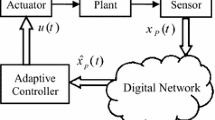Abstract
Because the existing methods do not consider the random data packet loss problem, there is a large test error, and the problem of non–static disturbance suppression cannot be achieved. For this reason, a nonlinear network disturbance suppression method based on chaos optimization algorithm is proposed. Given the basic structure of the nonlinear network control system, it is concluded that the nonlinear network is mainly affected by uplink interference and downlink interference. A class of nonlinear network control systems with random packet loss data is studied. The protection entropy is obtained to monitor the packet loss data. Finally, a chaos optimization algorithm is used to suppress nonlinear network disturbances. The experimental results show that the proposed method can effectively suppress the disturbance under the uplink interference and downlink interference, and the test error is relatively small, the mean square error is 0.29, the maximum positive error is 0.521, and the maximum negative error is 0.21, which shows that the method is effective and can eliminate the influence of interference factors on the stability of nonlinear network.





Similar content being viewed by others
References
Amiri R, Almasi MA, Andrews JG, Mehrpouyan H (2019) Reinforcement learning for self organization and power control of two-tier heterogeneous networks. IEEE Trans Wireless Commun 18(8):3933–3947
Bande M, Gamal AE, Veeravalli VV (2019) Degrees of freedom in wireless interference networks with cooperative transmission and backhaul load constraints. IEEE Trans Inf Theory 65(9):5816–5832
Buratti C, Verdone R (2018) Joint scheduling and routing with power control for centralized wireless sensor networks. Wireless Netw 24(5):1699–1714
Erick DAB, Da Silva MJ, Coelho LD, Bastos-Filho CJA, Martins Filho JF (2018) Amplifier adaptive control of operating point considering non-linear interference. IEEE Photonics Technol Lett 30(6):573–576
Haroon MS, Abbas ZH, Abbas G, Muhammad F (2020) Coverage analysis of ultra-dense heterogeneous cellular networks with interference management. Wireless Netw 26(3):2013–2025
Hyman JD, Jimenez-Martinez J (2018) Dispersion and mixing in three-dimensional discrete fracture networks: nonlinear interplay between structural and hydraulic heterogeneity. Water Resour Res 54(5):3243–3258
Jacobs M, Liang H, Dashtimoghadam E, Morgan B, Dobrynin AV (2019) Nonlinear elasticity and swelling of comb and bottlebrush networks. Macromol 52(14):5095–5101
Kawano Y, Besselink B, Scherpen JMA, Cao M (2020) Data-driven model reduction of monotone systems by nonlinear DC gains. IEEE Trans Autom Control 65(5):2094–2106
Kusaladharma S, Zhang Z, Tellambura C (2019) Interference and outage analysis of random D2D networks underlaying millimeter-wave cellular networks. IEEE Trans Commun 67(1):778–790
Larrousse B, Lasaulce S, Bloch MR (2018) Coordination in distributed networks via coded actions with application to power control. IEEE Trans Inf Theory 64(5):3633–3654
Liu J, Lian DY, Hu SN (2019) Mathematical modeling and simulation of synchronous control of asymmetric coupled sensor network. Comput Simulat 036(010):265–268,284
López, Onel L. Alcaraz, Alves H, Latva-Aho M (2019) Joint power control and rate allocation enabling ultra-reliability and energy efficiency in SIMO wireless networks. IEEE Trans Commun 67(8):5768–5782
Manfredi S, Angeli D (2018) Asymptotic consensus on the average of a field for time-varying nonlinear networks under almost periodic connectivity. IEEE Trans Autom Control 63(8):2389–2404
Mismar FB, Evans BL, Alkhateeb A (2020) Deep reinforcement learning for 5G networks: joint beamforming, power control, and interference coordination. IEEE Trans Commun 68(3):1581–1592
Pola G, Pepe P, Benedetto MDD (2018) Decentralized supervisory control of networks of nonlinear control systems. IEEE Trans Autom Contr 63(9):2803–2817
Samaranayake S, Krichene W, Reilly J, Delle MML, Goatin P, Bayen A (2018) Discrete-time system optimal dynamic traffic assignment (SO-DTA) with partial control for physical queuing networks. Transp Ence 52(4):982–1001
Sarikaya Y, Inaltekin H, Alpcan T, Evans JS (2018) Stability and dynamic control of underlay mobile edge networks. IEEE Trans Mob Comput 17(9):2195–2208
Schilcher U, Schmidt JF, Atiq MK, Bettstetter C (2020) Autocorrelation and coherence time of interference in poisson networks. IEEE Trans Mob Comput 19(7):1506–1518
Siyari P, Krunz M, Nguyen DN (2018) Distributed power control in a mimo interference wiretap network with full-duplex jamming receivers. IEEE Trans Signal Process 67(3):594–608
Sultan R, Song L, Seddik KG, Han Z (2020) Joint Resource management with distributed uplink power control in full-duplex OFDMA networks. IEEE Trans Veh Technol 69(3):2850–2863
Funding
There was no funding or grants received that assisted in this study.
Author information
Authors and Affiliations
Corresponding author
Ethics declarations
Conflict of interest
The authors declared that they have no conflicts of interest to this work. We declare that we do not have any commercial or associative interest that represents a conflict of interest in connection with the work submitted.
Additional information
Publisher's Note
Springer Nature remains neutral with regard to jurisdictional claims in published maps and institutional affiliations.
Rights and permissions
About this article
Cite this article
Zhang, Z., Chen, K. Nonlinear network disturbance suppression based on chaos optimization algorithm. Int J Syst Assur Eng Manag 14, 110–119 (2023). https://doi.org/10.1007/s13198-021-01201-z
Received:
Revised:
Accepted:
Published:
Issue Date:
DOI: https://doi.org/10.1007/s13198-021-01201-z




